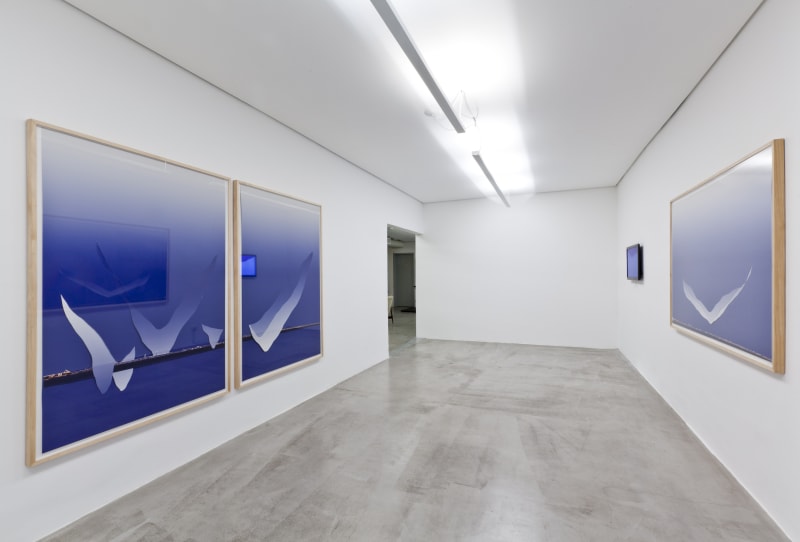Silver abyss
Abismos (Abysses). This was the title of the ‘work’ which became Lugar do Outro, the first solo exhibition of the Franco-Paulistana artist Julia Kater. The name is somewhat curious, given that landscapes dominate the set of works exhibited in the Zip’Up room (or else constructions that refer to the genre). But one piece, the video Tempo do Branco (Time of White), explains more about the ‘abyssal’ tone that was the catalyst for the artist's thinking behind the proto-title.
Tempo do Branco inverts the perspective of how we traditionally see landscape. Through a simple operation, what was before a blue/icy/grey sky, a secure backdrop, disintegrates and becomes an element of danger, like a bottomless pit (or with the ground quite some way down). The reference, a mountain range with peaks that could equally be in the Alps or any other range, becomes a mass of somewhat threatening, downward-pointing spikes (pointing down to what? In this sense, it relates to Vanderlei Lopes’ provocative piece Cathedral). Kater, literally, takes us off the ground. In her debut video, the artist gets the pitch just right in appealing to the risk factor, despite using only trivial resources.
The series Lugar do Outro, represented in this show through an isolated photograph and a diptych, conveys Kater's renowned ability to create photographic collages, in which she opts for a low fi key – the artist meticulously gathers sheets of cotton paper in layers marked by handmade incisions, dispensing with the use of commonplace post-production tools like Photoshop. The blue of the sky is designed not as something celebratory, but rather as a high-load element, destroying beautiful things, shifting and consuming what was apparently rigid and solid. The weight of the world. Diminutive and with dissolved curves, an undefined urban setting in the shape of a landscape is key to the composition, as it creates a reference, albeit fragile and remnant.
“[...] How and why does a work of art offer us questions and challenges, gifts and debts, glimpses and frustrations. [...] Through art, our dreams and our visions, our ghosts and our desires are transformed from within and metamorphosise into conditions to take in and absorb the works. This has always been necessary, and is especially so in these globalised times of the fleeting look and the fugitive image, of the weight of the words and the clash of rigmaroles, of these opiates of the masses and aimless drifting of mankind. Artists open our eyes and force us to reflect. Photographers even more so.” (1)
In these days of technological blah blah blah and shameless odes to ‘visionary’ businessmen of novelty machines, the density of Kater’s work gains an almost political character. And she stands out even more from her peers by emphasising the influence of cinema, literature and psychoanalysis on the artistic process; fields which should not clash, but rather coexist harmoniously. “Breton associated psychoanalysis, photography and literature, asserting that automatic writing was a true photography of our thoughts” (2). Thus, the artist can echo in her visual production characteristics of Antonioni and Lacan, Bergman and Jung, Sebald and Angelopoulos.
“Therefore, however different they may have been to each other, the great pioneers of modern cinema, from Rosselini to Godard, Bresson to Resnais, Tati to Antonioni, Welles to Bergman, are the ones whose art makes a radical break from the theatrical-propagandistic model, which, on the contrary, is omnipresent in classical cinema. They all share the feeling that they no longer really have any relationship with the same bodies as before. Before the [extermination] camps, before Hiroshima. And this is irreversible.
What is the setting for modern cinema, bearing in mind we are now dealing, in black humour, with a 'new man', with the survivors of post-industrial societies? With a body that has lost the basis of its weight, whose weak, faded x-ray is screened by a new-born television?” (3), wonders the film critic Serge Daney.
Time slips by slowly, not allowing us to easily seize it, as suggested by the dry point on the untitled photographic collage, in a grey/icy tone, arranged on the walls of the exhibition room, and by Kater’s other works, like the remarkable Juillet. They also demonstrate a palette shift (the link with painting is one of the triumphs of this artwork) to more neutral tones. “If we are sick with Eros, Antonioni said, it is because Eros is himself sick; and he is sick not just because he is old and worn out in his content, but because he is caught in the pure form of a time which is torn between an already determined past and a dead-end future.” (4)
Kater's plastic multiplicity is striking in Lugar do Outro. The photographic collages also bring traits of painting, drawing, engraving and three-dimensional work. “These latest works have more volume. They show a body made through its absence or remains, behind those layers” (5), the artist declares to critic Bruno Moreschi.
Julia Kater’s work, therefore, brings us into abyssal spaces, to self-knowledge, to fragmented and unstable movements, in an ongoing search that offers us more disquiet than defined and established results.
Mario Gioia
(1) SOULAGES, François. Estética da Fotografia – Perda e Permanência. São Paulo, Senac SP, 2010, p. 350 and 351
(2) SOULAGES, François. Idem, p. 226
(3) DANEY, Serge. A Rampa. São Paulo, Cosac Naify, 2007, p. 231
(4) DELEUZE, Gilles. A Imagem-Tempo. São Paulo, Brasiliense, 2009, p. 35
(5) MORESCHI, Bruno (org.). Um de Três – Carla Chaim, Julia Kater, Marcia de Moraes. São Paulo, Funarte, 2011, p. 40

